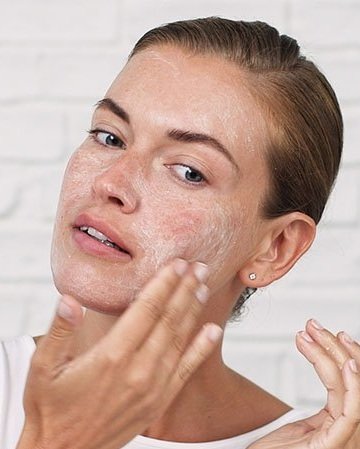5 Good Reasons to Exfoliate
1. The Three Main Acids
There are 3 main ingredients which can be found in exfoliators, which you may be familiar with. They are Salicylic, Glycolic and Lactic acids. These are also commonly known and found labelled on products as AHA’s (Alpha Hydroxy Acids) and BHA’s (Beta Hydroxy Acids). Lactic Acid which is an AHA has a large molecular weight, which means it mainly works on the top layer of the skin and is also a gentle acid, buffing away the surface layer to promote turnover. This acid will leave the skin feeling smooth and is not irritable. The second AHA is Glycolic Acid in comparison to Lactic Acid this ingredient has a smaller molecular weight and penetrates further into the skin layers, which helps greatly in breaking down pigmentation within the skin and to even out the skin tone. Thus improving the health of the skin. Glycolic Acid is great in retaining moisture. The most commonly known BHA is Salicylic Acid, those suffering with acne or breakouts will be the most familiar however it is good for every skin type and will benefit greatly as it deeply cleanses the pores, reduces black heads and white heads by breaking down the bonds of dead skin and releases the excess oils and dirt. This helps to prevent future breakouts or congestion within the skin that causes the bumpy texture. It also has anti-inflammatory properties, to calm the skin down from irritation such as the skin becoming sensitive, red and blotchy, calming the skin which also reduces the appearance of spots. You will find these ingredients are often used in a higher percentage in chemical peels, which is also another treatment that helps to rapidly exfoliate the skin and is recommended once a month.
2. The Results
Once the skin has been exfoliated you are left with a smoother complexion and the skin feels softer. This is because you have allowed the surface layer to expose new fresh skin. As you leave the dull look behind you, you will notice the skin looks glowly and slightly shiny but not in a greasy way. The pores also shrink in size and the skin structure looks stronger and plumper due to the skin speeding up cell renewal promoting more collagen production. Collagen production will help cushion out scarring in time and strengthen fine lines and wrinkles to looker softer and less noticeable. If you suffer from pigmentation or uneven skin tone, from hormonal stimulation, sun damage, or dark markings from previous breakouts you will notice the areas becoming lighter, as the damaged cells are broken down.
3. Absorption of Nutrients
Once cleansed, exfoliated and toned, you will proceed to use any necessary serums and moisturisers. The application of these products after exfoliating becomes more satisfying and therapeutic on the skin as they will glide and spread with ease, absorbing into the skin layers. If you did not exfoliate first and the dead skin cells were blocking the surface layer of the skin, then the product would only work superficially and not contribute to helping the underlying problems of the skin beneath the surface. Exfoliating benefits the other products you use which is why it is important to understand why you are doing each step to compliment the next step of your routine and the products become of more value to you.
4. Boosts the Skins Circulation
Exfoliating helps boost the skin circulation, which flushes out toxins in the body, such as free radicals from external and internal damage, for instance, smoking, pollution, diet, and lifestyle in general. Helping to drain the lymphatic system of these toxins helps to give the skin that healthy awakened look.
5. Exfoliating after Laser Hair Removal
When having Laser hair Removal (LHR) exfoliating on the face or body is great as it helps to unclog the pores and promote the hair to fall out. Unclogging the pores also helps ingrown hairs to be removed but also prevents ingrown hairs too. Some clients are left with markings, or inflammatory on the area, after shaving or picking at outbreaks that are caused from this. Clients that have previously waxed will experience this too. Those AHA and BHA acids will break down the pigment, unclog the pores and calm down the inflammation. You need to wait 7 days after LHR to start exfoliatation and you need to stop 7 days before your next session.
To Conclude exfoliating is a crucial part of your weekly skin care regime. It is recommended to exfoliate 2 – 3 times a week. Exfoliating is not recommended daily as it removes dead skin cells from the surface layer and while this is very important as it helps to cleanse the skin more deeply than a normal cleanse (as well as unclog pores, remove dirt and debris and promote cell turnover) if we over exfoliate, we could leave the skin to become quite dry and therefore the skin then produces excess sebum leaving the skin feeling oily so exfoliating every other day and with care will prevent this. This will also maintain a fresh youthful appearance, and leave the skin soft and supple. After exfoliating you should follow with a hydrating moisturiser to replenish the skin. Exfoliating aids in the penetration of nutrients and vitamins within serums and moisturisers, therefore when applied to the skin these key ingredients will absorb deeper into the skin layers as the surface will be clear of dead skin cells blocking this process.
Recommended Products: NOON Cosmo Clear Cleanser
Cosmo Clear by NOON is a perfect cleanser to start with if you want something calming for the skin with all the benefits of Salicylic, Glycolic and Lactic Acid. The product includes chamomile extracts to soothe the skin further, making it perfect even for those with sensitive skin. The cleanser will help to balance the skins PH, as it hydrates, removes dead skin cells and relieves any redness or irritation.

